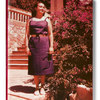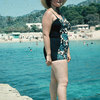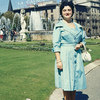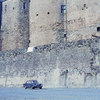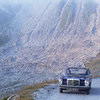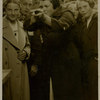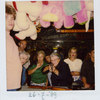Conversations about Photobooks: Erik Kessels
MORE IMAGES
“Taking photographs out of their context, showing them, editing them and talking about them makes you realize things.” - Erik Kessels
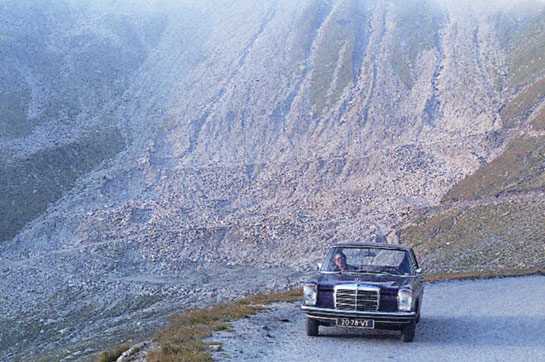
If you happen to come across a photobook showing you images of chicken filets and images from furniture ads, it’s like you’re looking at one of Erik Kessels’ products. Apart from owning and operating an ad agency (make sure to reload that site several times) and various other activities, Erik runs KesselsKramer Publishing, which is responsible for gems such as the In Almost Every Picture or Useful Photography series. To find out more about the ideas behind the work, I sat down with Erik on a sunny late-November morning in Amsterdam to ask some questions. (more)
Jörg Colberg: You publish a lot of books containing photographs that a lot of people probably think should not be in a photobook. What is it that makes these photographs interesting for you? Why do you publish books with found photos, “useful” photos?
Erik Kessels: I think it has to do with my background. I’m educated as an art director and graphic designer, and I work a lot with photographers and imagery. When there’s a photo shoot for a job I have to go through fifty or one hundred shots, and I make a selection. That has always been around me, to do that job.
But I also hated a lot of that work because in advertizing the images are like a big cliché, they are full of stereotypes. That’s why fifteen years ago we started our own agency. We felt a strong need to change that a little bit. Since then I have worked with a lot of photographers that never did a commercial job before. I try to put authentic work into campaigns, because authenticity and advertizing - that has a little friction. It’s almost not possible.
In my work I’m always very interested in the authenticity of things.
On weekends, I go to flea markets. I have been doing that for twenty years now. At some stage, I started finding a lot of photo albums. Photographs from the past ended up at flea markets just because the family had no relatives. The houses get emptied by dealers, and they just sell the images.
The first time I found a really long series was in Barcelona, around 400 images, a husband photographing his wife for twelve years. They were just lying there, and it started to rain. They were big slides, 6x6 slides, and the husband wrote the place and the date on them. They were in a big crate, a beautiful object. So I bought it for ten Euros, and I almost could not carry it. When I got home I looked at the slides. It was amazing that it was almost only the woman being portrayed in these photographs. I showed them to a lot of people, who were really touched and amazed by them. I didn’t think about publishing them. But people told me “You should take them out of the drawer,” and…
JC: … that’s how the series started, In Almost Every Picture?
EK: Yeah. I had an exhibition of the photographs plus the book presentation in Barcelona. I made an invite, with a poster, asking if people could hang it in their windows, to see if somebody knew that woman. It was picked up a lot by newspapers. I found out that the woman had lived alone with her husband. They had no children. She had died fifteen years ago, the husband died five years after her, and so the photographs ended up at the flea market - there were no relatives.
That’s how it started, how I became interested in how sometimes amateurs produce very important photo series.
This past Summer I spent a long time in the US, and I saw that there is ten times more of that photography than here. In America, especially in the 50s and 60s, people really photographed a lot. They still do that, but back then it was all kept in boxes, in albums. There was a whole culture created around that, and it slowly came to the rest of the world as well.
I’m interested in the imperfections that you find in these images, which makes them authentic. But I’m also interested in the stories. I have a lot of albums, thousands, and some are not interesting. But when they’re at a flea market, and they’re five or ten dollars then I buy them because I can’t leave them there.
JC: Often, the stories are very touching. I remember the one book you did with the photos of the woman in the cab in Austria [In Almost Every Picture #2]. How did you find out what the story actually was?
EK: Those photos were given to me by Andrea Stultiens, as a consequence of the first book. There was a student who lived above that taxi driver, and when the taxi driver died the student saved all the 700 slides from the garbage. Through an acquaintance he gave them to Andrea, who I made that book with. There were 700 slides, and each had only the taxi in it. The driver stepped out of the car, you know the story…
JC: … to take a picture.
EK: We then found out that the woman in the car, the passenger, was handicapped. She was unable to get out of the car. We found out about it because the driver had a little notebook in which he wrote distances traveled etc. We saw that he frequently picked up somebody at the same address, which we then went to. That’s how we learned that the woman was handicapped.
But most of the times, you can’t track the information down any longer. In the back of the book it always says “If the photographs in this book belong to you, they will be dutifully returned” But that hardly ever happens.
JC: What about Useful Photography? How did you start that?
EK: Friends of mine (Hans Aarsman, Claudie de Cleen, Julian Germain and Hans van der Meer) and I realized that we had the same hobby: we collected the same kind of imagery. Imagery which at a first glance is pretty unimportant, mundane. If you enlarge it and put it on the wall in a frame it is a bit shocking. But after a while it becomes a beautiful image, taken out of its context. That kind of imagery we live with every day, and we don’t know the names of the photographers who make it. We also never re-use it. We just consume that kind of imagery.
JC: We often don’t even really look at the images.
EK: No. It’s a certain category of photography where that happen. Photography of meat, of clothes is always like that. Our idea was to take those photos out of their context and then put them together, in a different environment. Suddenly people looked at the images again, because they were dis-located.
JC: I don’t know whether people realize this but a lot of the work is not just collecting the images, it’s also making the right selection so that the story actually comes out?
EK: Yeah
JC: So you must spend a lot of time thinking about what you can do with them, or does it come naturally, like you look and you see “Oh, well, this is exactly what it should be”?
EK: Yeah. In a way it comes naturally, but you never know when it happens. Sometimes, you also make up a little bit of a story, which might be true or might not be true. For instance, the book with the black dog [In Almost Every Picture #9] doesn’t have a huge story but when you see all these photographic mistakes… You need to leave a little bit of space for people to come up with their own story.
That was amazing about the first book of the woman from Barcelona. After I had published it I saw many more of those series because people sent them to me. I could have made ten of those books, with the same kind of extensive series.
Taking photographs out of their context, showing them, editing them and talking about them makes you realize things. When you go through the book of the Spanish woman you see that with time she becomes smaller in the images. In the last ones she’s very small. After many years the photographer had lost a little bit of interest in his subject, and he got more interested in the landscapes and surroundings. In the beginning he stayed very close to her. It’s a bit sad. But it says a lot about life.
JC: I guess it point at that even simple, amateurish images often contain much more meaning and information than people think.
EK: Yeah. And also they’re much deeper and more touching than many photos by professional photographers. But that’s also not a good comparison, because those private photographs are what they are, there’s a certain naivete in them.
JC: They’re not made for an audience.
EK: They’re made for a small audience, groups of friends. There are lots of interesting stories in them. For example, occasionally I buy a box with albums of one family and their whole life. And you see there’s always the same system. The first album shows how two people meet, and for the first time they go on vacation together. They’re very excited and very much in love. In the second album they get married, it’s the marriage album, with friends, a party, the ceremony. The third album is dedicated to the first child. Hundreds of pictures of that first baby. The first few years of their child. And then the fourth, fifth, and sixth one are a total mix of… maybe twenty years. The second child, the third child, the first child grows up, holidays etc. And then the last album is very much comparable to the first one because the couple is alone again. The children have left the the home, and the couple goes on vacation together again, just the two of them. It’s almost like the first album.
There’s a photobook by Lee Friedlander called Maria, and in that book you see the same system. The first picture in the book and the last picture are identical almost. They’re on holiday together. In between she’s pregnant, she gets older, she needs to work for the children.
I’m always interested in how we record life.
JC: I never realized that you can look at family albums that way, almost use the albums, they way they’re sorted, almost showing the human condition of a family.
EK: There are weird things…. Sometimes you have the secret images in back pockets of albums. Mistresses, naked pictures, all those kinds of things. Those have a lot of stories.
But I don’t totally depend on albums, that’s just one thing. I don’t want to be seen as only collecting photo albums or making photobooks. I’m just interested in imagery and in how people consume it.
And that’s very important in my advertizing work because when I make a campaign and I need a photograph of somebody I try to get a photograph where that person has maybe a big pimple or spot somewhere, and I don’t retouch it. For a commercial client I try to leave it. That’s the same authenticity I’m looking for.
I also learn a lot by the things I find. It’s inspiring, and I use that in the commercial work.
JC: So then that’s why and how these books are really very much part of what you do in your advertizing agency, right?
EK: I don’t know exactly what I’m doing because it’s so scattered these days. I teach at a theater school, I make a children’s TV program, I design stamps for the post office, I curate exhibitions, I make exhibitions with my own collection, I make photobooks…. And I am the co-founder of a company in Amsterdam and London. It’s a very good time for that now.
When I started out I always wanted to do those things, but that was not possible, because every discipline was stuck in its own rules and had its own borders that you couldn’t cross. I like to cross over a lot of disciplines, and that inspires me.
It’s amazing that when I had the first big exhibition in Utrecht in 2006, nine spaces in that whole museum, with around 2,000 square meters, nobody in the press said “Come on, there suddenly is this advertizing guy who ends up in a museum with his stuff? How could this happen?” I had thought they’d definitely write that.
JC: And they didn’t.
EK: No, because I think that was maybe more my own idea. Because I come from a time where when somebody would ask me at a party “What do you do?” and I said “I work in an advertizing agency” she would change the subject matter. Now, it’s totally different.
JC: It’s great for you because it gives you lots of opportunities. I’m almost in the same situation, I do all these different things, and people don’t really mind.
EK: In a few years’ time we probably won’t even talk about it any more. But if I didn’t have the energy or if I wasn’t interested in it all of this it wouldn’t have happened for me. People that work in the industry I work in don’t get it. They’re totally lost today.
I also see this as a luxury, of course. I don’t depend on the income that comes out of the work with found photographs or exhibitions. But we also never finance the books with money directly out of the agency. I think it should be kept separate. Otherwise, things become a bit easy.
Sometimes, a book, a dummy, lies around for two years, and nobody is interested; and sometimes things get thrown away.
JC: Oh really?
EK: Yeah, if it’s not good enough, it’s maybe too easy.
JC: So how does that work? Do you have a set of dummies that you have and then people look, and you get feedback and you decide which ones will be published?
EK: Mostly it works with pdf now. We send them to distributors, and they are interested or not. When there’s an interest, and they can give a certain guarantee, then you know approximately how many you can sell. On that basis you can produce something.
In our case, with these books, it’s not that we print 10,000 of them. There were other books that we made, for instance with our work as an agency, which we didn’t publish ourselves. Some of those sold 15,000 or 20,000 copies.
Right now I got a really nice opportunity. I got invited by Dutch Book Week. That’s an event every year in March. They pick somebody to write a book for that week. This year, they asked me to approach it from an image point of view. My idea is to take a series of photographs, almost random from a certain family, and then to give that family a second chance. I manipulate it a little bit, make a fiction out of it, and I collaborate with a writer, who is also inspired by the images and by the story that I make of it. There are 48,000 copies to be printed. That’s really interesting for me, with images like this to be that prominent in a normal, mainstream market. Those are nice experiments.
We are also going to produce a perfume, based on the images and the story. The book is called Good Luck, because the two people might get a happy ending or not. The perfume is also called Good Luck, based on the stories and on the pictures. A scent creator, inspired by those stories and pictures, makes a smell for those two people. It’s a unisex perfume. While you read the book you can wear a perfume that is inspired by it.
JC: And all that from found images, done by amateurs and not by artists.
EK: Yeah. I like those kinds of new challenges. I’m pretty happy with something like that. Because usually there still is only a small market for it.
I found out that it helps if the books come with a story. For instance, the book I made with the woman shooting [In Almost Every Picture #7] was was made two years ago. But a while ago somebody put it again on his blog, all the images. “The woman who shoots herself.” And suddenly his site totally exploded. In one day he had 94,000 visitors. It was Lensculture. The whole site crashed, he had to buy a new server. Within two weeks, it got everywhere. But that was two years after the book was published.
The whole story is almost like a film. It’s fantastic. First, you have the images, which she shot for 70 years. After the book came out Stedelijk Museum in Amsterdam bought the original photos from her. She was 89 years old at that time. For her it was an amazing amount of money. But in Holland there was also a big scandal, at least amongst photographers. A lot of photographers on the internet were complaining “Why are they buying this work? We are photographers, but she never had a camera in her life.” This Summer, I went with her to Arles. Of all the people in those books [In Almost Every Picture] who is still alive. When I went to Arles she had a plastic gun in her hand luggage.
 By
By 